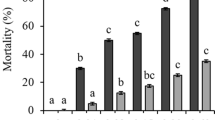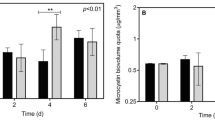Abstract
We cultured individuals of two Daphnia species and their hybrid on two different algae, Scenedesmus obliquus and Chlamydomonas globosa, in different concentrations. Our results suggest that culture conditions of S. obliquus can be such that the algal cells become toxic to Daphnia
Similar content being viewed by others
References
Ahlgren, G., L. Lundstedt, M. T. Brett & C. Forsberg, 1990. Lipid composition and food quality of some freshwater phytoplankton for cladoceran zooplankters. J. Plankton Res. 12: 809–818.
Beattie, D. M., H. L. Golterman & J. Vijverberg, 1979. An introduction to the limnology of the Friesian Lakes. Hydrobiologia 58: 49–64.
Boersma, M. & J. Vijverberg, in prep a. Synergistic effects of different food species on life history traits of Daphnia galeata.
Boersma, M. & J. Vijverberg, in prep b. Effect of food concentration on growth, reproduction and longevity of Daphnia galeata, Daphnia cucullata, and the hybrid between these species.
Bohrer, R. N. & W. Lampert, 1988. Simultaneous measurement of the effect of food concentration on assimilation and respiration in Daphnia magna Straus. Funct. Ecol. 2: 463–471.
de Bernardi, R. & G. Giussani, 1990. Are blue-green algae a suitable food for zooplankton? An overview. Hydrobiologia 200/201: 29–42.
de Haan, H., J. B. W. Wanders & J. R. Moed, 1982. Multiple addition bioassay of Tjeukemeer water. Hydrobiologia 88: 233–244.
DeMott, W. R., Q. X. Zhang & W. W. Carmichael, 1991. Effects of toxic cyanobacteria and purified toxins on the survival and feeding of a copepod and 3 species of Daphnia. Limnol. Oceanogr. 36: 1346–1357.
Duncan, A., W. Lampert & O. Rocha, 1985. Carbon weight on length regressions of Daphnia spp. grown at threshold food concentrations. Verh. int. Ver. Limnol. 22: 3109–3115.
Elendt, B. P., 1989. Effects of starvation on growth, reproduction, survival and biochemical composition of Daphnia magna. Arch. Hydrobiol. 116: 415–433.
Elendt, B. P. & W. R. Bias, 1990. Trace nutrient deficiency in Daphnia magna cultured in standard medium for toxicity testing. Effects of the optimization of culture conditions on life history parameters of D. magna. Wat. Res. 24: 1157–1167.
Forsyth, D. J., J. F. Haney & M. R. James, 1992. Direct observation of toxic effects of cyanobacterial extracellular products on Daphnia. Hydrobiologia 228: 151–155.
Gliwicz, Z. M. & W. lampert, 1990. Food thresholds in Daphnia species in the absence and presence of blue-green filaments. Ecology 71: 691–702.
Hartmann, H. J. & D. D. Kunkel, 1991. Mechanisms of food selection in Daphnia. Hydrobiologia 225: 129–154.
Hessen, D. O. & E. van Donk, 1993. Morphological changes in Scenedesmus induced by substances released from Daphnia. Arch. Hydrobiol. 127: 129–140.
Infante, A. & A. H. Litt, 1985. Differences between two species of Daphnia in the use of 10 species of algae in Lake Washington. Limnol. Oceanogr. 30: 1053–1059.
Jeppesen, E., M. Søndergaard, O. Sortjaer, E. Mortensen & P. Kristensen, 1990. Interactions between phytoplankton and fish in a shallow, hypertrophic lake: a study of phytoplankton collapses in Lake Søbygård, Denmark. Hydrobiologia 191: 149–164.
Klapes, N. A., 1990. Acute toxicity of the natural algicide, Cyanobacterin, to Daphnia magna. Ecotoxicol. Envir. Safety 20: 167–174.
Kryutchkova, N. M. & V. Sládeček, 1969. Quantitative relations of the feeding and growth of Dapnia pulex obtusa (Kurz) Scourfield. Hydrobiologia 33: 47–64.
Lundstedt, L. & M. T. Brett, 1991. Differential growth rates of 3 cladoceran species in response to mono-algal and mixed-algal cultures. Limnol. Oceanogr. 36: 159–165.
Meyer, J. S., C. G. Ingersoll, L. L. McDonald & M. S. Boyce, 1986. Estimating uncertainty in population growth rates: Jacknife vs. Bootstrap techniques. Ecology 67: 1156–1166.
Mitchell, S. F., F. R. Trainor, P. H. Rich & C. E. Goulden, 1992. Growth of Daphnia magna in the laboratory in relation to the nutritional state of its food species, Chlamydomonas reinhardtii. J. Plankton Res. 14: 379–391.
O'Brien, W. J. & F. deNoyelles, 1972. Photosynthetically elevated pH as a factor in zooplankton mortality in nutrient enriched ponds. Ecology 53: 605–614.
Rothhaupt, K. O., 1991. The influence of toxic and filamentous blue-green algae on feeding and population growth of the rotifer Brachionus rubens. Int. Revue ges. Hydrobiol. 76: 67–72.
Ryther, J. H., 1954. Inhibitory effects of phytoplankton upon the feeding of Daphnia magna with reference to growth, reproduction, and survival. Ecology 35: 522–532.
Sivonen, K., S. I. Niemela, R. M. Niemi, L. Lepisto, T. H. Luoma & L. A. Räsänen, 1990. Toxic cyanobacteria (blue-green algae) in Finnish fresh and coastal waters. Hydrobiologia 190: 267–275.
Spaak, P. & I. R. Hoekstra, 1993. Clonal structure of the Daphnia population in Lake Maarsseveen: its implications for diel vertical migration. Arch. Hydrobiol. 39: 157–165.
Taub, F. B. & A. M. Dollar, 1968. The nutritional inadequacy of Chlorella and Chlamydomonas as food for Daphnia pulex. Limnol. Oceanogr. 13: 607–617.
Tessier, A. J., L. L. Henry, C. E. Goulden & M. W. Durand, 1983. Starvation in Daphnia: Energy reserves and reproductive allocation. Limnol. Oceanogr. 28: 667–676.
Urabe, J., 1991. Effect of food concentration on growth, reproduction and survivorship of Bosmina longirostris (Cladocera): an experimental study. Freshwat. Biol. 25: 1–8.
Weider, L. J. & H. G. Wolf, 1991. Life-history variation in a hybrid species complex of Daphnia. Oecologia 87: 506–513.
Vijverberg, J., 1976. The effect of food quantity and quality on the growth, birth-rate and longevity of Daphnia hyalina Leydig. Hydrobiologia 51: 99–108.
Vijverberg, J., 1989. Culture techniques for studies on the growth, development and reproduction of copepods and cladocerans under laboratory and in situ conditions: a review. Freshwat. Biol. 21: 317–373.
Walter, B., 1969. Interrelations of Cladocera and algae. Ph.D. Thesis, Westfield Coll. Univ. London.
Author information
Authors and Affiliations
Rights and permissions
About this article
Cite this article
Boersma, M., Vijverberg, J. Possible toxic effects on Daphnia resulting from the green alga Scenedesmus obliquus . Hydrobiologia 294, 99–103 (1994). https://doi.org/10.1007/BF00016849
Received:
Accepted:
Issue Date:
DOI: https://doi.org/10.1007/BF00016849




